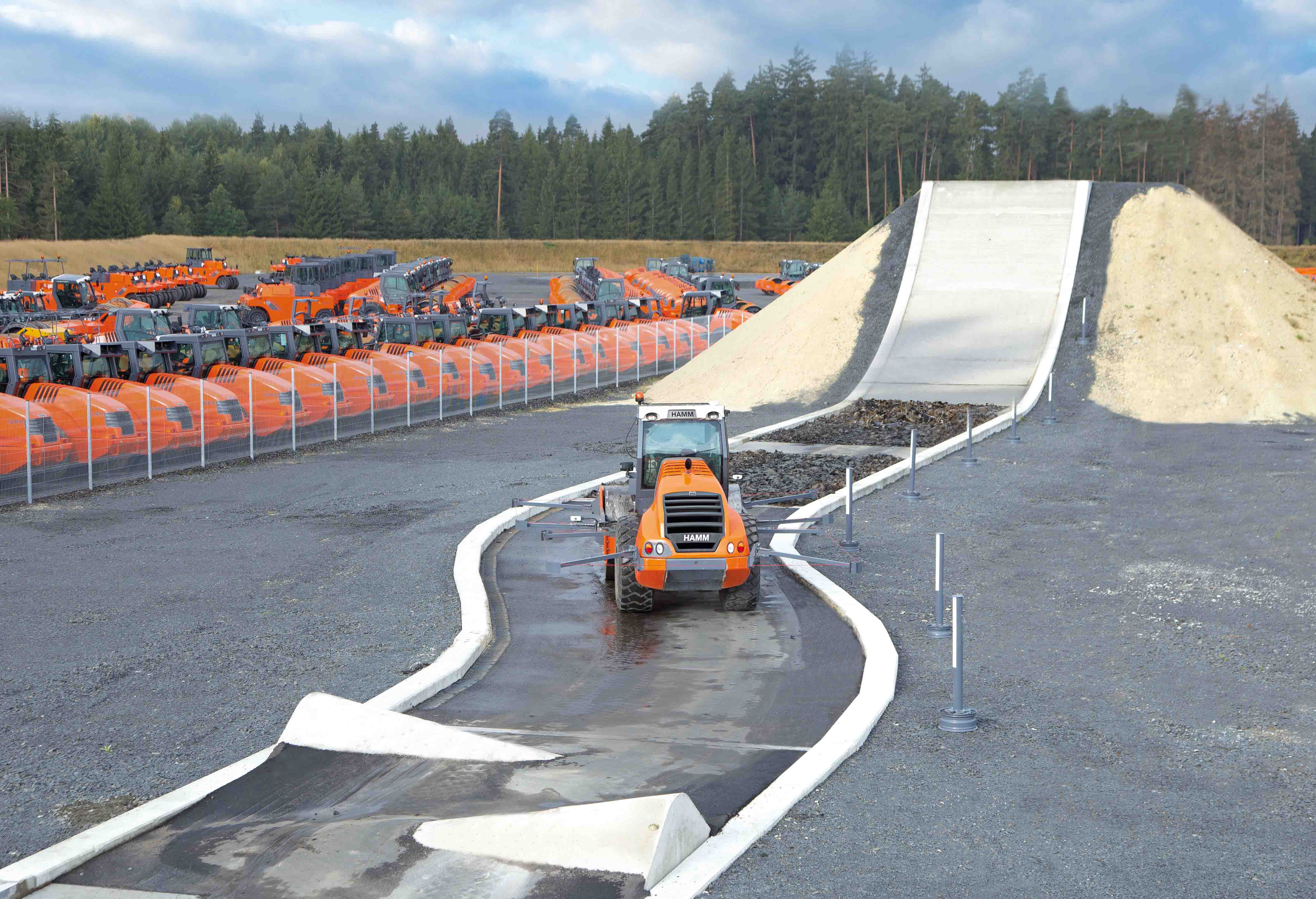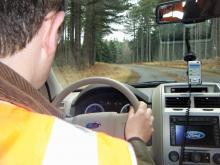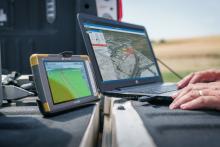
Autonomous vehicles that can move around without human intervention are not yet a part of everyday life, but they are almost within reach. In daily life, things like autonomous lawnmowers and window-cleaning robots are springing up like mushrooms. Hamm’s chief technology officer, Dr Stefan Klumpp, explains how his company’s ideas are changing the game for compaction contractors around the world
Right now, there is only a small number of self-driving machines working every day on the world’s leading highway construction sites but, make no mistake, things are changing fast. Assistance systems are rapidly establishing themselves on virtually every sort of vehicle used in the construction sector.
In the field of compaction technology,
Although the ability to compact surfaces entirely autonomously without any sort of direct human intervention is still some years away, Hamm has already demonstrated that its autonomous machines will allow contractors to significantly increase their compaction quality and efficiency standards.
You only have to look at modern cars and trucks to see that “the use of assistance systems is experiencing rapid growth,” says Hamm. “GNSS systems for navigation, speed control, spacers, lane assistants, parking and steering aids or automatic switching on and off of the dipped beam are increasingly establishing themselves. In many countries, they are even standard on new vehicles.”
“These assistance systems form the basis of the self-driving trucks and cars that are being developed by industry pioneers, and that are already being put through their paces on test tracks.”
And, according to Dr Stefan Klumpp, CTO (chief technology officer) of Hamm, “this development will not stop at construction machinery. Rollers for asphalt and soil compaction will be among the first vehicles in which such systems will widely establish themselves.” Why? Because, Klumpp continues, “in many respects, the (rollers in question) are closer to cars than many other types of construction machinery. This is why we have been dealing with this subject for some time at Hamm.”
Klumpp believes that Hamm is a pioneer in this field. “We know of no other company in our industry with a self-driving roller,” he said. “Our investigations have shown that such rollers enable our customers to increase compaction quality and efficiency. We have noticed that other leading companies in their sectors are also looking into the opportunities and impacts of the ‘autonomous construction site’.”
For example, he adds, “we have maintained a dialogue on this subject for some time with a number of our customers. Against the background of limited availability of qualified personnel on the one hand, and high-quality, highly efficient and resource-saving use of machinery on the other, the objective is to further optimise construction processes.”
Dr Axel Römer, head of research and design at Hamm, has already examined with his team what a self-driving roller might look like. “We have considered technical, constructive and economic aspects and evaluated them in various studies,” he told World Highways.
“The result is a driverless roller that will not have an operator’s platform any more but will need significantly more sensors to monitor not only the compaction parameters but also the area surrounding the roller. We have connected these requirements and see many new and constructive possibilities.”
For example, Römer adds, “we could construct autonomous rollers with significantly larger drum diameters, bigger water tanks and more space for the batteries of electrically-powered rollers. This offers advantages in terms of quality, environmental friendliness and efficiency.”
In collaboration with a range of industrial designers, Hamm has drawn up a concept plus design study. “The result,” according to Römer, “is impressive … in particular the drum of the 9tonne machine with its diameter of just under 2m. At the same time, the overall height of the machine is significantly lower than that of current machines with a cab or roof.
“There is a long road to travel before such a machine will become reality,” says Hamm, “but we as a company have a horizon of decades for projects like this. The journey, however, began long ago and we already have numerous assistance systems in use on site.”
A good illustration of this would be the gamechanging HCQ Navigator. “Using an onboard computer and GNSS data,” Hamm explains that the HCQ Navigator “provides a real-time display of the areas that have already been compacted, including how often and by how much.”
“This is complemented by driving functions such as automatic reversing or speed control, as well as safety features such as rear-view cameras. All of them relieve the burden on drivers and, even today, help to increase compaction quality.”
So far, so good, and the developers at Hamm are now working on other systems such as a lane assistant, additional steering aids and the further development of the HCQ Navigator.
Hamm knows that to drive this new technology further forward, the designers will need to include “more sensors and more intelligent software.” Systems far better than those found in today’s machines will be required for rollers that are able to manoeuvre autonomously in carrying out high-quality compaction says the company.
“The sensors will be used to capture all relevant data from the area surrounding the roller,” says Hamm. “This includes spatial position, direction of travel, distance from other objects, current material parameters of the surface to be compacted – such as temperature and rigidity, as well as weather information including wind or cooling rates.”
“The rollers must compare this data with specifications for the area, such as which parts should be compacted, as well as things like the rolling pattern ... how many and what sort of rollers do we want to put to work together?”
Other parameters will include the desired compaction standard including the desired void content, alongside the compaction strategy, “including instructions for cornering before reversing, edge-finishing, vehicle speed, the use of exciter systems, and so on,” says Hamm. “In short, this is a complex undertaking.”
This is not just a question of theory though, it is being proven in practice. Hamm has done more than 10,000 hours of endurance testing at its Tirschenreuth factory, and has already developed a driverless shadowing roller that follows the preceding lead machine.
The company’s endurance test track has been “operational since 2014, with the primary purpose of testing prototypes.” Since then, “the researchers at Hamm have been testing their new developments under reproducible conditions in around-the-clock operation for weeks at a time – with no driver at the wheel.”
In these trials, “the machines autonomously complete a specified programme, drive themselves to refuelling points and park themselves when the test is completed,” says Hamm. “To prevent collisions with persons or objects, the developers have fitted the rollers with comprehensive surroundings-monitoring systems.”
“We have learned a great deal about autonomous driving in the process,” says engineer Hans-Peter Patzner, who collaborated in the development of the control system for the project. Patzner is now looking ahead to the next challenge, as a second test track at Hamm comes on stream designed to allow two different rollers to drive simultaneously. “For this, we have designed a collision monitoring system, which represents another important step towards autonomous driving,” says the automation specialist.
This second project has a different focus. In collaboration with the University of Osnabrück, the team has successfully converted a roller that, without a driver, automatically follows a simulated road paver. According to Römer, “taking forward the concept of this shadowing roller, we can leverage a great deal of potential by automating the compaction process. There will be an increase in quality thanks to compliance with lanes and windows of speed. Targeted braking of the roller will also avoid going beyond the rolling areas and any subsequent over-compaction.”
He believes that “the extremely precise change of compaction lanes will help to prevent deformation. Together, these systems automatically lead to greater efficiency, in particular when such concepts are applied across the fleet.”
Whatever form autonomous compaction will take, “it will be realised via assistance systems,” says Klumpp. “Step by step in the years to come, these systems will relieve the burden on drivers. And every new assistance function will be beneficial for the compaction process.”
As long as the way in which the surroundings of the machine are monitored is not precise enough for fully autonomous driving, a roller driver will have to be in the cab. “He would only take over in specific situations,” says Klumpp. “For example for refuelling, during loading and unloading, or in the event of unforeseen incidents. A similar situation already prevails in the field of aviation … in modern commercial aircraft, the autopilot and other systems carry out the greater part of in-flight tasks. The pilots only control the aircraft during take-off and landing, and in exceptional situations, otherwise their main task is to monitor the processes.”
Another key driver will be the law. “There are a number of legal issues to consider before such rollers can be put to work on the ‘autonomous construction site’ of the future,” says Hamm.
“A number of questions arise, such as: Who is liable in the case of damage caused by a self-driving machine: the manufacturer, the owner, the planner? Also, questions will have to be answered regarding the assessment of unclear cases: Should the control system be configured such that nearby objects are protected, or should optimum compaction quality always take precedence? Manufacturers and users will have to discuss such aspects with clients, authorities, politicians and legislators.”
There is no quick fix. “We think that, even in 50 years, we will still need and construct asphalt and concrete roads,” says Klumpp. “However, to take a step closer to self-driving machines, the general environment must change, including the construction process itself.”
Klumpp has looked at the self-driving machines used in the mining sector. “There,” he says, “highly standardised work is carried out in closed systems; there are few points of contact with the outside world and few unforeseeable influences on the process. Under such clearly defined boundary conditions, giant dumpers are already transporting rock across large mines that span kilometres – without a driver.”
In road construction, by comparison, “the processes are far less clear-cut and less easy to structure. Every construction site is a little different. There is also much more contact with the surroundings, and thus more potential hazard, and user behaviour is not uniform.” If the highway construction sector is going to leverage the true potential of automation, it will have “to introduce larger construction sections and more standardisation (and) a change in thinking among the planners and contractors.”
Also, of course, the job of the roller driver will change. The shortage of skilled drivers is already an issue on many sites in the developed world, so it might be beneficial to use experienced drivers as “roller managers who configure and supervise an entire fleet of machines – perhaps even working from an office,” says Hamm.
“This kind of development will initially occur in the high-wage countries, provided that it entails qualitative and commercial advantages. In this case, it would be the achievement of cost savings through greater efficiency, and with fewer staff. In addition, reworking would be eliminated thanks to higher quality.” Of course, “this will demand suitable interfaces and planning tools on the part of planners and customers, as well as a corresponding legal framework. This environment will have to evolve in parallel with the machines.”
Whatever happens next, Hamm’s Dr Klumpp is clear: “We have formulated our vision. This has resulted in individual projects that, little by little, will lead us to autonomous compaction. For some, our long-term objective may still sound like science fiction. But in 20 or 30 years, it will be a reality … even routine. Eventually, aided by our developments, the road construction site of the future will become more cost-effective and more efficient. Things are going to get better.”












